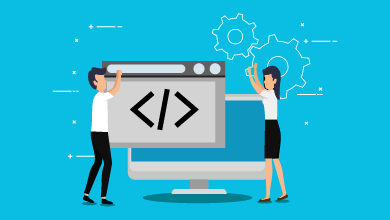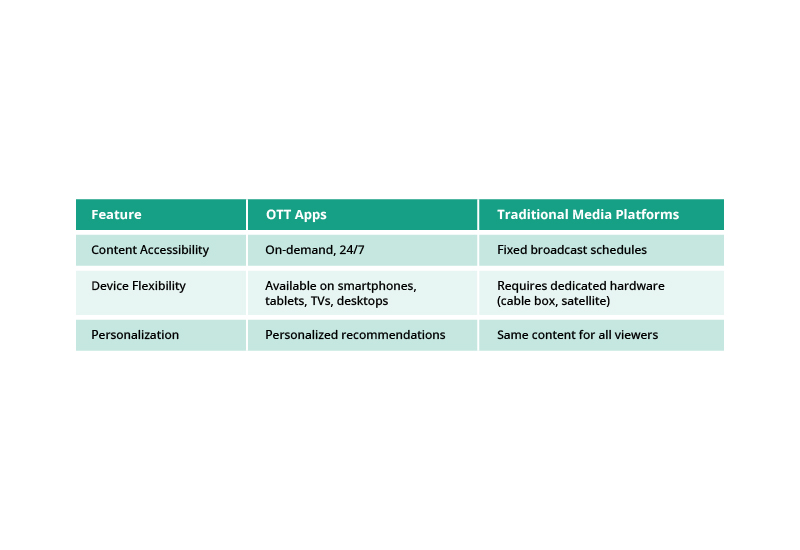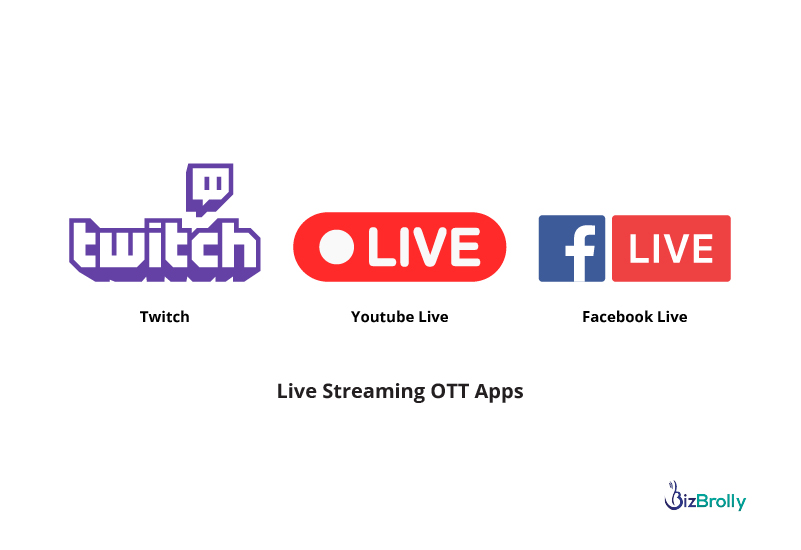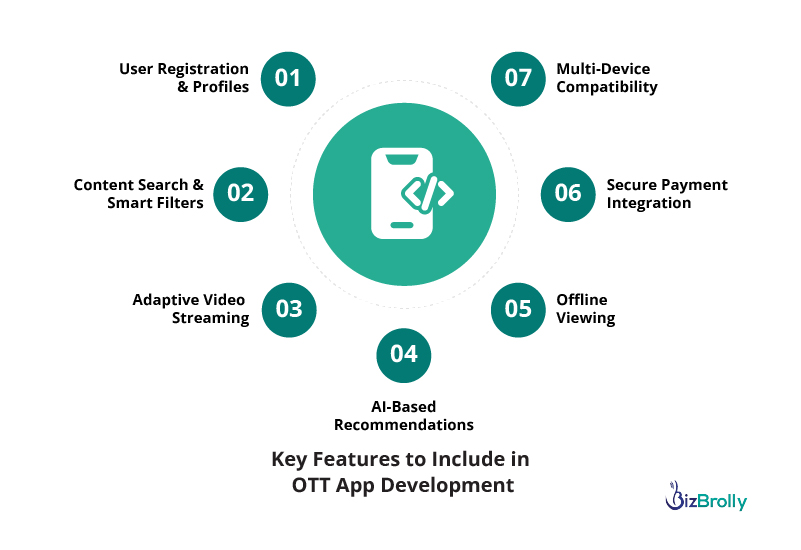OTT App Development 101: Types, Features, Market Trends & Cost Analysis


Streaming has become the new standard of entertainment, with OTT (Over-the-Top) apps at the forefront of this transformation. From binge-watching series to catching live sports and listening to on-demand music, OTT apps have revolutionized how content is consumed globally. With just a smartphone, smart TV, or laptop, users can access high-quality entertainment tailored to their tastes, available anytime and anywhere.
The OTT market is experiencing significant growth. According to Technavio, the global OTT market is projected to grow by USD 630.5 billion from 2024 to 2028, at a CAGR of 27.77% . In India, the OTT audience universe has expanded to 547.3 million users as of 2024, reflecting a 14% year-on-year growth and a penetration rate of 38.4% .Technavio Reports+2PR Newswire+2GII Research+2Ormax Media Pvt. Ltd.+3The Economic Times+3Campaign India+3
OTT app services—like Netflix, Prime Video, Disney+ Hotstar, and Spotify—offer unmatched convenience, extensive content libraries, and flexible pricing models. Unlike traditional TV, there’s no need to follow fixed schedules or depend on cable setups. Whether it’s video, audio, or live streaming, OTT platforms have evolved to meet every consumer need.
For businesses, the rise of OTT is not just a trend—it’s an opportunity. With user preferences shifting rapidly toward digital and mobile-first experiences, launching an OTT app can unlock significant potential. But with opportunities come decisions: What type of OTT app should you build? How much will it cost? What features should you include?
In this blog, we’ll break down the different types of OTT apps, explore monetization strategies, and provide a detailed cost breakdown to help you plan your next move.
The shift from traditional broadcasting to OTT platforms is not just a fad—it’s a global phenomenon driven by changing consumer behavior, rapid internet penetration, and the demand for on-demand content.
Here’s why OTT platforms are winning over traditional TV and media:
Unlike traditional cable TV, which follows a fixed schedule, OTT platforms allow users to watch or listen to content at their convenience. Whether commuting, working out, or relaxing at home, content is just a tap away.
OTT apps use advanced algorithms and AI to offer personalized recommendations based on user behavior and preferences. This tailored experience keeps viewers engaged, making content consumption more enjoyable.
Traditional TV requires cable connections, set-top boxes, and sometimes even installation fees. OTT apps, on the other hand, only need an internet connection and a compatible device, making them cost-effective and easy to access.
From global blockbusters to regional originals, OTT apps offer an extensive variety of content in multiple languages and genres. This inclusivity ensures that there’s something for everyone.
Unlike traditional pay-TV, which often locks customers into long-term contracts, OTT platforms provide various subscription models—freemium, pay-per-view, or ad-supported—offering flexibility and affordability.
OTT providers can gather instant data on viewer preferences, watch time, and engagement. This real-time feedback helps platforms refine content strategy—something traditional media can’t match.
OTT services can cater to a global audience while also offering region-specific content. This ability to blend global distribution with localized storytelling gives them a massive edge.

OTT platforms can be classified based on the type of content they deliver and the business models they follow. Understanding these categories will help you choose the right format for your app idea or identify the most suitable type of service for your audience.
These are the most popular type of OTT platforms. They deliver video content including movies, web series, TV shows, documentaries, and more. Examples include Netflix, Amazon Prime Video, Disney+, and Hulu.
These platforms focus on delivering music, podcasts, and audiobooks. Spotify, Apple Music, and Audible are leaders in this space.
Apps like WhatsApp, Telegram, and Signal use OTT technology to provide voice calls, messaging, and video chats over the internet, bypassing traditional telecom networks.
These apps enable users to make voice calls via the internet instead of traditional telephone lines. Skype and Zoom are examples that serve both personal and enterprise users.
Live OTT platforms like Twitch, YouTube Live, and Facebook Live allow users to stream content in real-time—ranging from gaming and events to educational webinars.

Developing an OTT app requires a systematic approach to ensure a seamless user experience, robust functionality, and scalability. The development process involves several key stages, each focused on different aspects of the app’s functionality, performance, and design.
Before diving into the development process, it’s essential to validate the idea behind the OTT app. This involves understanding the target audience, market trends, competition, and identifying the unique value proposition of the app. Research will help refine the app’s concept, determine the types of content to be included, and decide on the business model (SVOD, AVOD, or freemium).
Once the app idea is validated, the next step is to define the key features that will make the app stand out. Depending on the type of OTT service (video, music, live streaming, etc.), features may vary. Essential features for OTT apps include:
This phase also involves choosing between native or hybrid app development.
UI/UX design is critical in OTT app development, as it directly impacts user retention and engagement. The design should focus on a clean, intuitive interface with easy navigation for content discovery. The experience should be seamless across devices such as smartphones, tablets, and TVs. Key aspects to consider include:
This is the core phase of OTT app development. Depending on the platform (iOS, Android, Smart TVs, etc.), developers will choose the appropriate programming languages and frameworks. During development, it’s essential to implement features like content encryption, streaming protocols, and backend services.
The development team will also work on integrating third-party services such as payment gateways (for subscriptions), content delivery networks (CDNs), and analytics tools.
Quality assurance ensures that the app works as intended and is free from bugs. This includes functional testing, performance testing (especially streaming speed and quality), compatibility testing across devices, and security testing to prevent unauthorized access.
Once the app is developed and tested, it’s time to launch. However, just launching the app isn’t enough; effective marketing strategies are essential to drive installs and engage users. Marketing efforts may include:
After launch, it’s important to continuously monitor the app’s performance and user feedback. Regular updates, bug fixes, and feature enhancements should be implemented to ensure the app remains competitive and meets user expectations. Maintenance may also include content updates, performance optimizations, and security patches.
To build a successful OTT app, focusing on the right set of features is crucial. These features not only enhance user engagement but also ensure platform scalability and monetization.

Allow users to register using email, mobile, or social media. Profile management lets users create individual viewing profiles, track watch history, and receive personalized content recommendations. This also helps in parental control for family-based subscriptions.
An intuitive search bar combined with filters (genre, language, popularity, etc.) improves content discoverability. This ensures users spend less time searching and more time watching, enhancing the overall user experience.
Support various streaming qualities such as SD, HD, and 4K that automatically adjust based on internet speed. This ensures buffer-free playback and maintains video quality across devices and networks.
Leverage AI to analyze user behavior and recommend relevant content. This boosts viewer retention by making the app feel more personalized and responsive to user preferences.
Allow users to download content for offline access. This is a highly requested feature, especially for users who travel or have limited data access, ensuring uninterrupted viewing.
Incorporate trusted payment gateways for subscriptions or pay-per-view services. Support for global and local payment options ensures a smooth and secure transaction experience for all users.
Ensure the OTT app runs seamlessly across mobile phones, tablets, smart TVs, and web browsers. A consistent experience across platforms increases user engagement and retention.
When it comes to OTT app development, understanding the cost structure is essential for businesses that want to create a successful platform. The total cost of building an OTT app depends on several factors, including features, platform, complexity, and design requirements. In this section, we’ll break down the key cost elements involved in OTT app development.
The first factor that impacts the cost of your OTT app is the platform(s) it will be built for. Will it be for iOS, Android, web browsers, or multiple platforms? Developing an app for multiple platforms requires more resources and time, which will naturally increase the cost.
User interface and experience design play a critical role in the success of your OTT app. A well-designed app ensures users have an easy time navigating through content and interacting with various features. Depending on the level of customization and complexity, the design can cost anywhere from $5,000 to $15,000.
The features of your OTT app have a direct impact on the overall cost. Some of the common features include content streaming, payment integration, user profiles, recommendation systems, live chat support, and more. The more complex and customized the features, the higher the cost.
To ensure smooth video streaming, you need a reliable and scalable infrastructure. This typically involves cloud services like Amazon Web Services (AWS) or Microsoft Azure, video hosting platforms, and a content delivery network (CDN) to ensure fast content delivery to users worldwide.
Security is a crucial aspect of any OTT platform. Features like digital rights management (DRM), encryption, and secure payment processing require additional development and infrastructure, adding to the overall cost of the app.
The backend is the server-side part of your OTT app, which handles user data, content management, and transactions. A well-developed backend ensures seamless content delivery and data management. The cost for backend development depends on the complexity and the features of the backend architecture.
To ensure the app functions smoothly and provides a great user experience, thorough testing and quality assurance (QA) are essential. The testing process involves checking for bugs, compatibility issues, performance, and user experience. Testing can take several weeks to a few months, depending on the complexity of the app.
Once the app is live, ongoing maintenance is crucial for ensuring it runs smoothly. Maintenance includes bug fixes, updates to keep up with OS upgrades, and adding new features. Typically, app maintenance costs range from 15% to 20% of the initial development cost annually.
Marketing your OTT app is necessary to ensure it gains traction and attracts users. Depending on your strategy, marketing can include paid ads, social media campaigns, influencer marketing, and more. These costs vary based on the scope and reach of your marketing efforts.

Monetizing an OTT app is crucial for sustaining long-term growth and profitability. There are various monetization strategies available to app developers, each tailored to different types of content and target audiences. In this section, we will explore the most popular OTT app monetization models and their respective benefits.
The Subscription Video On Demand (SVOD) model is one of the most common monetization strategies for OTT apps. Users pay a recurring fee (usually monthly or annually) for access to premium content. This model provides a steady, predictable revenue stream and is ideal for platforms offering a large library of content.
In the Advertisement Video On Demand (AVOD) model, users can access content for free but are shown advertisements during their viewing experience. Advertisers pay the OTT platform based on the number of views, clicks, or impressions their ads receive.
Transactional Video On Demand (TVOD) allows users to pay for individual pieces of content they want to watch, rather than subscribing to a monthly or yearly plan. This is also known as a “pay-per-view” model.

The freemium model provides basic content for free, but users can access additional premium content by purchasing a subscription or making in-app purchases. This model often uses limited access to content to hook users and convince them to pay for better experiences.
The hybrid model is a combination of two or more of the monetization models described above. For example, a platform might offer free content with ads, but also provide a subscription plan that removes ads and offers additional features.
Some OTT platforms, especially those producing niche or independent content, may opt to generate revenue through crowdfunding or user donations. This model can be effective for smaller creators or startups, who leverage community support to fund operations.
Content licensing and syndication allow OTT platforms to earn revenue by selling content rights to other platforms or broadcasters. This model is common for platforms that produce original content and then license it to other networks.
As OTT apps continue to evolve, keeping up with emerging trends is crucial for staying competitive and relevant in the market. Here are some future trends that are expected to shape the OTT industry:
Artificial Intelligence (AI) and Machine Learning (ML) are set to revolutionize how content is delivered to users. OTT platforms are leveraging these technologies to provide highly personalized content recommendations based on users’ viewing behavior, preferences, and even time of day. This enhances user engagement by suggesting content they are more likely to watch, leading to improved retention rates.
Interactive content, such as live streaming, real-time polls, and live comments, is becoming a popular trend in OTT apps. Viewers are no longer passive consumers but are seeking ways to engage with content, share opinions, and be part of the experience. Live streaming, especially of sports, concerts, and events, has become a major draw for OTT platforms.
AR and VR technologies are expected to become key components of OTT app development in the future. These immersive technologies provide unique experiences that can redefine how users consume content. OTT platforms could incorporate AR or VR to create virtual theaters or even offer 360-degree video content, giving users a more interactive and immersive viewing experience.
OTT platforms are increasingly integrating social media features within their apps. This allows users to share what they are watching, discuss content with friends, and follow their favorite creators or shows. Social media integration can also help OTT providers engage with their audience in real-time and attract new users through viral content.
OTT services are moving toward bundling their offerings with other services. For example, offering discounted or combined subscriptions with music streaming, news, or other entertainment services. This model will enable OTT platforms to provide more value to customers, making them a one-stop entertainment solution.
At BizBrolly, we specialize in delivering comprehensive OTT app development services tailored to meet the unique needs of your business. As a leading custom software development company, we focus on creating high-quality streaming experiences that resonate with your audience.
We prioritize user-friendly design, combining intuitive UX/UI with advanced features like AI-powered recommendations, multi-device support, live streaming, and content protection. Our team ensures your app stays ahead of the curve by integrating the latest technologies and optimizing its performance for seamless scalability, handling increased traffic and content demands.
Monetization is a key focus in our development process. We help you implement subscription models, ads, or pay-per-view options that align with your business goals and customer segments, ensuring revenue generation while providing flexibility. Our approach also includes robust security measures like DRM and encrypted payment gateways to protect your content and user data.
From development to post-launch support, we provide end-to-end solutions to ensure your OTT app remains secure, optimized, and future-ready. At BizBrolly, we are committed to delivering a top-tier streaming experience, enabling your business to stand out in the competitive OTT market and keep your users engaged.

In recent years, artificial intelligence (AI) has rapidly advanced, with neural ...
Explore more
Cloud computing is transforming the manufacturing industry by making it easier t...
Explore more


D-23, Sector 63, Noida,
UP - 201307

141 Westgate Dr, Edison,
NJ - 08820

4 Black lion court, Mill road, Kent, UK – ME71HL

2207, 2220 Lakeshore Blvd W, Toronto ON- M8V0C1

94A Central Road, Jacanlee, Johannesburg 2194